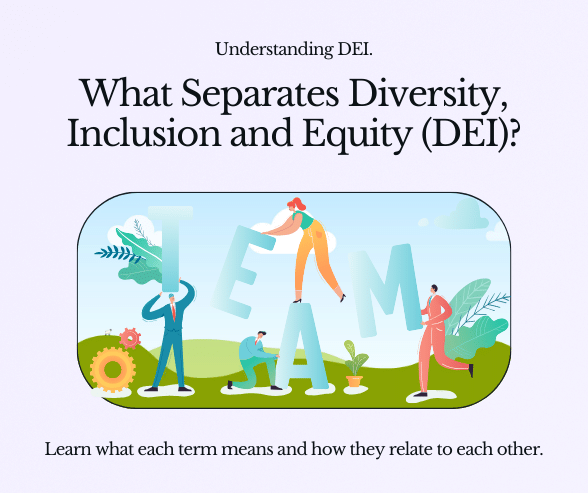
Diversity, inclusion and equity are all essential components of any successful organization.
Organizations know that representation without inclusion and equity is diversity that does not stick. But what exactly do these separate but interconnected concepts mean? One way to think about it, in Verna Myers’ words (who is a renowned culture expert and global leader in the DEI space), is that “diversity is being invited to the party” while inclusion is “being asked to dance”.
The addition of equity can be thought of as ensuring everyone at the party is treated fairly and has an accessible way of travelling there and back.
Diversity
To start, diversity can be understood as representation: having individuals with different backgrounds present at the table to share their own unique perspectives. Different backgrounds are not limited to factors like race, ethnicity, or gender — they also include intersecting factors such as sexual orientation, socio-economic status, education, age, and physical abilities.
What’s important to note is that diversity is not about maintaining set quotas of individuals across certain groups. Rather, diversity is about having access to diverse perspectives and ideas, while also preventing groupthink. In an increasingly diverse world, diverse teams are best suited to represent and serve the different needs and wants of customers.
Inclusion
Although achieving diversity is a great first step, teams need inclusion for diversity to stick. Not only do we need different voices to be present at the table, but these voices should be able to contribute and be heard.
Inclusive organizations are ones where individuals of all backgrounds are able to bring their authentic selves at work, and feel secure, accepted and heard. In inclusive teams, employees from “non-dominant” groups are empowered to share ideas, and team members are open to different opinions and perspectives.
Corporate leaders who set the tone from the top can aim to foster inclusive organizations by encouraging collaborative teamwork, respect and compassion, and an receptiveness to differences.
Equity
Last but not least, equity is about employees across the board having an equal opportunity to thrive and advance at their organization. One key component of equity is fair workplace management and culture.
This includes implementing an employee feedback and review system that is fair, objective, and free from unconscious bias, ensuring all employees have access to career development resources just as mentors, and striving for a transparent workplace free of nepotism and favoritism.
Beyond fair workplace culture, offering flexible work options is also a crucial component of equity. Flexible work options include supporting employees with different needs with programs for parental leave, mental health resources, and remote work options.
We are beyond the initial days of just speaking of diversity in isolation.
Related: Equality vs Equity
It’s Not Just About Compliance
Regardless of the specific industry, having diverse individuals included at work and treated equitably is not just the right thing to do, it also makes business sense. As BCG found after surveying 700 companies of varying sizes and geographies, diverse management teams are more innovative than less diverse teams. They are also 87% better at making decisions, as diverse perspectives lead to more innovative solutions.
Along with diversity, inclusion and equity helps organizations think outside the box and thrive amidst challenges so they can reach their full potential.
At Diversio, we understand the complexities of managing DEI initiatives
Our AI-powered platform provides the tools and insights needed to navigate these challenges effectively. Receive personalized guidance from our team of DEI experts to navigate and evolve your DEI initiatives and build DEI competency across your organization with evidence-based training programs.
Book a Demo with a DEI specialist at Diversio today!
Frequently Asked Questions About the Concept of Diversity, Equity and Inclusion
What are the first steps to creating a DEI strategy?
To create a DEI strategy, start by conducting a thorough assessment of your current workplace culture and demographics. Engage with employees through surveys and focus groups to understand their experiences. From there, set clear, measurable goals and develop an action plan that includes training, policy changes, and regular progress reviews.
Read our guides about:
What role does leadership play in DEI?
Leadership sets the tone for the organization. They should model inclusive behavior, hold themselves and others accountable for DEI goals, and actively promote a culture of equity and inclusion through policies, practices, and communication.
How can companies ensure DEI efforts are effective?
To ensure DEI efforts are effective, companies should regularly track and evaluate their progress using specific metrics. Soliciting feedback from employees, conducting regular training, and being willing to adjust strategies based on what is working or not working are also key components.
What is the difference between equality and equity?
Equality involves treating everyone the same, while equity focuses on providing individuals with the resources and opportunities they need to succeed, which may differ based on their unique circumstances. Equity aims to level the playing field, acknowledging that different people have different needs and starting points.

